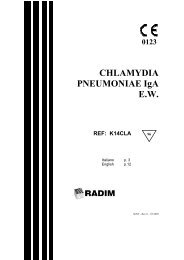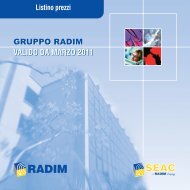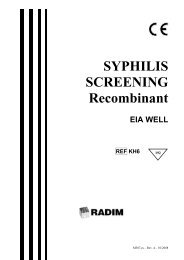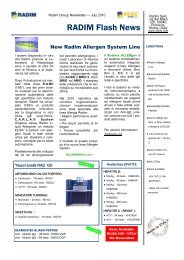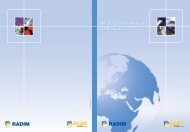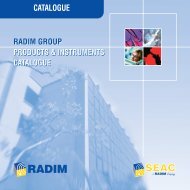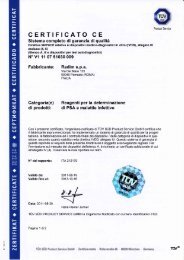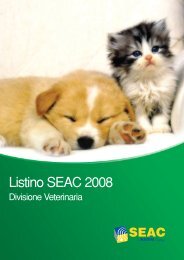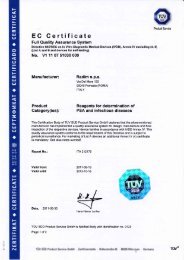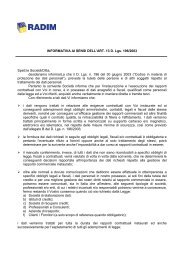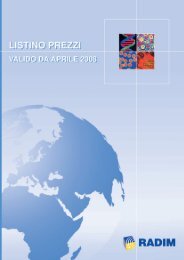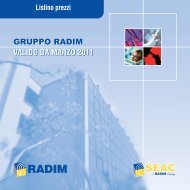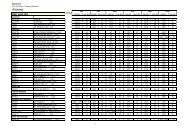17β ESTRADIOLO - Radim S.p.A.
17β ESTRADIOLO - Radim S.p.A.
17β ESTRADIOLO - Radim S.p.A.
You also want an ePaper? Increase the reach of your titles
YUMPU automatically turns print PDFs into web optimized ePapers that Google loves.
DESTINAZIONE D’USO<br />
Metodo competitivo immunoenzimatico<br />
colorimetrico per la determinazione<br />
quantitativa della concentrazione del 17β<br />
Estradiolo nel siero e plasma umano.<br />
1. SIGNIFICATO CLINICO<br />
L’Estradiolo (17β Estradiolo) è un ormone<br />
sessuale. Rappresenta l'estrogeno principale<br />
negli esseri umani. L'Estradiolo ha effetto sul<br />
funzionamento riproduttivo e sessuale, e<br />
interessa altri organi compresa la struttura<br />
dell'osso. Durante gli anni fertili la maggior<br />
parte dell’Estradiolo nelle donne è prodotto<br />
dalle ovaie, piccole quantità sono prodotte<br />
dalla corteccia surrenale. Negli uomini, i<br />
testicoli producono l’Estradiolo. Nel plasma<br />
l’Estradiolo è legato alla globulina legante gli<br />
ormoni sessuali (SHBG), e all'albumina, -<br />
soltanto la frazione libera è biologicamente<br />
attiva. La quantità di Estradiolo sierico nelle<br />
donne riflette soprattutto l'attività delle ovaie.<br />
I livelli di estrogeni durante la gravidanza<br />
aumentano costantemente fino al termine della<br />
stessa. Aumenti dei livelli di Estradiolo<br />
portano alla sintesi della placenta. Nelle<br />
donne in premenopausa, la produzione ovarica<br />
di Estradiolo è stimolata dall'ormone<br />
luteinizzante (LH) e dell'ormone follicolostimolante<br />
(FSH) durante il ciclo mestruale.<br />
Nelle donne, i livelli di Estradiolo misurano la<br />
fertilità e le irregolarità mestruali e sono<br />
necessari per controllare la funzionalità dei<br />
follicoli ovarici durante l'induzione dell’<br />
ovulazione. Nelle donne, l’Estradiolo funge<br />
da ormone per lo sviluppo dei tessuti degli<br />
organi riproduttivi e guida lo sviluppo delle<br />
17β <strong>ESTRADIOLO</strong><br />
Determinazione immunoenzimatica per la<br />
Deternimanzione 17β Estradiolo<br />
nel siero o plasma umano.<br />
REF KSO003EW<br />
KSO003EW - 17-β <strong>ESTRADIOLO</strong><br />
M545 – Rev.0 – 05/2010 – Pag. 1/12<br />
caratteristiche sessuali secondarie, esso è<br />
coinvolto anche nella fertilità maschile.<br />
L’Estradiolo regola il mantenimento della<br />
massa ossea. Donne in menopausa subiscono<br />
una perdita accelerata della massa dell'osso<br />
dovuta alla mancanza di estrogeni.<br />
L’Estradiolo interessa la sintesi delle proteine,<br />
come le lipoproteine, delle proteine carrier e<br />
delle proteine responsabili della coagulazione.<br />
Gli estrogeni hanno funzione neuroprotettiva.<br />
L’Estradiolo, per la sua attività, è coinvolto in<br />
alcuni tipi di cancro, come il cancro al seno e<br />
il cancro del rivestimento uterino. In più ci<br />
sono parecchie circostanze ginecologiche<br />
benigne che dipendono dagli estrogeni quali<br />
ad esempio l’endometriosi.<br />
2. PRINCIPIO DEL METODO<br />
Il 17β Estradiolo (antigene) presente nel<br />
campione, compete con l’antigene marcato<br />
con perossidasi (HRPO) per il legame con un<br />
numero limitato di anticorpo anti-17β-<br />
Estradiolo adsorbito su micropiastra (fase<br />
solida).<br />
Dopo l’incubazione, la separazione<br />
dell’antigene libero da quello legato si ottiene<br />
mediante semplice lavaggio della fase solida.<br />
Viene quindi aggiunto il Tampone Substrato<br />
(H2O2-TMB).<br />
L’enzima presente nella frazione legata,<br />
reagendo con il Tampone Substrato (H2O2-<br />
TMB), sviluppa una colorazione blu che vira<br />
al giallo dopo aggiunta del Reagente<br />
Bloccante (H2SO4). Si procede con la<br />
determinazione dell’assorbanza.
La concentrazione di 17β Estradiolo nel<br />
campione viene calcolata in base ad una serie<br />
di calibratori.<br />
L’intensità del colore sviluppato è<br />
proporzionale alla concentrazione di antigene<br />
marcato e quindi inversamente proporzionale<br />
alla concentrazione del 17β Estradiolo<br />
presente nel campione.<br />
3. REATTIVI, MATERIALI E<br />
STRUMENTAZIONE<br />
3.1 Reattivi e materiali forniti nel kit<br />
• Conservare tutti i reattivi a 2-8°C, al riparo<br />
dalla luce.<br />
• I reagenti forniti sono sufficienti per 96<br />
pozzetti.<br />
CAL CALIBRATORI<br />
6 fl. di 17β Estradiolo, pronti per l’uso.<br />
Conservante Proclin 300
• Evitare l’esposizione del reattivo TMB-<br />
H2O2 alla luce diretta, ai metalli o agli<br />
agenti ossidanti.<br />
• Questo metodo consente di determinare<br />
concentrazioni di 17β Estradiolo da 20<br />
pg/mL a 2000 pg/mL.<br />
• La somministrazione di cortisone, steroidi<br />
naturali o sintetici può alterare i livelli<br />
ematici di 17β Estradiolo.<br />
5. PROCEDURA DI DOSAGGIO<br />
5.1 Preparazione della Soluzione di<br />
Lavaggio<br />
Prima dell’uso, diluire il contenuto del flacone<br />
della Soluzione di Lavaggio con acqua<br />
distillata fino ad ottenere un volume finale di<br />
500mL. Per preparare volumi minori<br />
rispettare il rapporto diluizione 1:10. La<br />
soluzione di lavaggio diluita è stabile a 2-8°C<br />
per 30 giorni. Nella soluzione di lavaggio è<br />
possibile osservare la presenza di cristalli, in<br />
tal caso agitare a temperatura ambiente fino a<br />
completa dissoluzione dei cristalli, per una<br />
maggiore precisione, diluire tutto il flacone<br />
della soluzione di lavaggio avendo cura di<br />
trasferire anche i cristalli con il lavaggio del<br />
flacone, poi agitare fino a completa<br />
dissoluzione.<br />
5.2 Preparazione del campione<br />
La determinazione del 17β Estradiolo può<br />
essere effettuata su plasma o siero. Se il<br />
dosaggio non viene effettuato lo stesso giorno<br />
del prelievo conservare il campione a -20°C.<br />
Prima dell’uso lasciare almeno 5 minuti su<br />
agitatore rotante.<br />
5.3 Procedimento<br />
Poiché è necessario eseguire il dosaggio in<br />
doppio, allestire due pozzetti per ogni punto<br />
della curva di Calibrazione (CAL0 – CAL5),<br />
due per ogni Campione ed uno per il Bianco.<br />
Dispensare:<br />
KSO003EW - 17-β <strong>ESTRADIOLO</strong><br />
M545 – Rev.0 – 05/2010 – Pag. 3/12<br />
CAL Campione Bianco<br />
CAL (0-5) 25 μl --- ---<br />
Campioni --- 25 μl ---<br />
CONJ 200 μl 200 μl ---<br />
Incubare 2 h a +37°C.<br />
Togliere la miscela di reazione, lavare i<br />
pozzetti 3 volte con 300 µL di soluzione di<br />
lavaggio diluita.<br />
Dispensare:<br />
CAL Campione Bianco<br />
SUBS 100 μl 100 μl 100 μl<br />
Incubare 30 minuti a temperatura ambiente<br />
(20-25°C), al riparo dalla luce.<br />
Dispensare:<br />
CAL Campione Bianco<br />
STOP 100 μl 100 μl 100 μl<br />
Leggere l’assorbanza (E) a 450 nm<br />
azzerando con il Bianco.<br />
“Qualora si utilizzasse nel procedimento<br />
operativo uno strumento automatico per<br />
micropiastre RADIM e/o SEAC, far<br />
riferimento al relativo manuale.”<br />
6. CONTROLLO QUALITA’<br />
Per controllare le prestazioni del dosaggio<br />
ciascun laboratorio deve testare i propri<br />
controlli con range di valori di Estradiolo<br />
normali, elevati e bassi. Questi controlli<br />
devono essere trattati allo stesso modo dei<br />
campioni e testati in ciascuna procedura di<br />
dosaggio eseguita. I dati del Controllo Qualità<br />
devono essere mantenuti per monitorare le<br />
prestazioni dei reagenti forniti. Si devono<br />
impiegare, inoltre, adeguati metodi statistici<br />
per verificare l’andamento delle prestazioni.<br />
Ciascun laboratorio deve stabilire i propri
limiti di accettabilità riguardo alle<br />
caratteristiche di prestazione del dosaggio.<br />
Altri parametri da monitorare sono le<br />
intercette dell’80, 50 e 20% della curva di<br />
calibrazione per valutare la riproducibilità<br />
inter-saggio. Inoltre, il valore massimo di<br />
assorbanza deve concordare con i dati ottenuti<br />
in precedenza.<br />
Deviazioni significative dai limiti prestabiliti<br />
possono indicare impreviste modifiche nelle<br />
condizioni sperimentali o una degradazione<br />
dei reagenti forniti. Per accertare la causa<br />
delle suddette variazioni è necessario<br />
utilizzare reattivi freschi.<br />
7. LIMITI DELLA PROCEDURA<br />
7.1 Caratteristiche del dosaggio<br />
Campioni microbiologicamente contaminati,<br />
altamente lipemici o emolizzati non devono<br />
essere utilizzati con questo test. Per ottenere<br />
risultati riproducibili è importante che il<br />
tempo di reazione sia mantenuto costante in<br />
ogni pozzetto. Il tempo impiegato per la<br />
dispensazione dei campioni non deve superare<br />
i dieci minuti.<br />
Se viene utilizzata più di una piastra si<br />
raccomanda di ripetere la curva dose-risposta.<br />
L’aggiunta del tampone substrato innesca una<br />
reazione cinetica che viene interrotta a seguito<br />
dell’aggiunta del reagente bloccante. Durante<br />
la dispensazione del tampone substrato e del<br />
reagente bloccante deve essere seguita la<br />
stessa sequenza, in modo da evitare qualsiasi<br />
differenza nei tempi di reazione. Il lettore per<br />
micropiastre misura le OD in senso verticale:<br />
non toccare, pertanto, il fondo dei pozzetti. La<br />
non completa aspirazione del liquido dai<br />
pozzetti durante la fase di lavaggio può dar<br />
luogo a scarsa riproducibilità e a falsi risultati.<br />
7.2 Interpretazione dei Risultati<br />
KSO003EW - 17-β <strong>ESTRADIOLO</strong><br />
M545 – Rev.0 – 05/2010 – Pag. 4/12<br />
Se per il calcolo dei risultati viene utilizzato<br />
un sistema computerizzato, è indispensabile<br />
che i valori attesi dei calibratori cadano entro<br />
il 10% delle concentrazioni assegnate.<br />
8. RISULTATI<br />
8.1 Estinzione media<br />
Calcolare l’estinzione media (Em) di ciascun<br />
punto della curva di Calibrazione e di ogni<br />
campione.<br />
8.2 Curva di Calibrazione<br />
Riportare sul grafico delle assorbanze i valori<br />
calcolati delle estinzioni medie (Em) di<br />
ciascun calibratore (CAL0 – CAL5) in<br />
funzione della concentrazione. Tracciare la<br />
curva attraverso i punti di calibrazione indicati<br />
(es.: elaborazione a Quattro Parametri<br />
Logistici).<br />
8.3 Calcolo dei risultati<br />
Interpolare i valori dei campioni sulla curva di<br />
calibrazione per ottenere la corrispondente<br />
concentrazione espressa in pg/mL.<br />
Nel caso si utilizzi uno strumento automatico<br />
per micropiastre RADIM e/o SEAC, la lettura<br />
spettrofotometrica è eseguita automaticamente<br />
a 3 lunghezze d’onda: 450, 405 e 620 nm,<br />
permettendo l’ampliamento del range di<br />
lettura.<br />
9. VALORI DI RIFERIMENTO<br />
Le concentrazioni seriche o plasmatiche di<br />
17β Estradiolo sono comprese nei seguenti<br />
intervalli:<br />
DONNE Fase follicolare 30 – 100 pg/mL<br />
Picco Ovulatorio 130 – 350 pg/mL<br />
Fase Luteinica 50 – 180 pg/mL<br />
Menopausa < 60 pg/mL<br />
BAMBINI < 40 pg/mL<br />
UOMINI < 60 pg/mL<br />
10. PARAMETRI CARATTERISTICI
10.1 Precisione<br />
10.1.1 Ripetibilità (intra-saggio)<br />
La variabilità intra-saggio è stata determinata<br />
testando in unico dosaggio (10 replicati) di<br />
tre diversi campioni di siero. La variabilità<br />
intra-saggio è risultata < 9.4%.<br />
10.1.2 Riproducibilità (inter-saggio)<br />
La variabilità inter-saggio è stata valutata<br />
attraverso la determinazione di tre diversi<br />
campioni di siero con due kit appartenenti<br />
lotti diversi. La variabilità inter-saggio è<br />
risultata 10%.<br />
10.2 Specificità<br />
La cross-reattività dell’anticorpo impiegato<br />
presenta le seguenti reazioni crociate,<br />
calcolate al 50% secondo Abraham:<br />
Analita % Cross-reattività<br />
Estradiolo 100<br />
Estrone 2<br />
Estriolo 0,39<br />
Testosterone 0,02<br />
Cortisolo < 7 x 10 -3<br />
Progesterone < 3 x 10 -4<br />
DHEA-S < 1 x 10 -4<br />
10.3 Accuratezza<br />
La prova di diluizione effettuata su campioni<br />
ad altra concentrazione di 17β Estradiolo ha<br />
dato un valore di recupero medio (±DS) di<br />
99.8% ± 15.5% in riferimento alle<br />
concentrazioni originali.<br />
KSO003EW - 17-β <strong>ESTRADIOLO</strong><br />
M545 – Rev.0 – 05/2010 – Pag. 5/12<br />
10.4 Sensibilità<br />
La concentrazione minima rilevabile di 17β<br />
Estradiolo, calcolata sottraendo 2x DS alla<br />
media di 10 replicati del Calibratore 0 è<br />
risultata pari a 8.7 pg/mL.<br />
10.5 Correlazione con kit in commercio.<br />
Il kit “17β Estradiolo” è stato comparato con<br />
un altro kit di 17β Estradiolo disponibile in<br />
commercio. Sono stati testati 18 campioni di<br />
siero utilizzando entrambi i metodi.<br />
E’ stata quindi calcolata la curva di<br />
regressione lineare:<br />
y = 1.026 x – 12.96<br />
r = 0.996 (r 2 = 0.994)<br />
11. DISPOSIZIONI PER LO<br />
SMALTIMENTO<br />
I reagenti devono essere smaltiti in accordo<br />
con le leggi locali.<br />
12. NOTE SULL’AUTOMAZIONE<br />
- Il dispositivo può essere utilizzato con<br />
strumentazione automatica di kit ELISA su<br />
micropiastra.<br />
- Si garantisce l’applicabilità su<br />
strumentazione RADIM e/o SEAC.<br />
- Qualora si utilizzi strumentazione<br />
automatica di altri fornitori è responsabilità<br />
dell’utilizzatore assicurarsi che il kit sia<br />
stato opportunamente validato.<br />
13. LEGENDA SIMBOLI: vedi pag. 11
INTENDED USE<br />
Competitive immunoenzymatic colorimetric<br />
method for quantitative determination of<br />
17β Estradiol concentration in human serum<br />
or plasma.<br />
1. CLINICAL SIGNIFICANCE<br />
Estradiol (17β Estradiol) is a sex hormone. It<br />
represents the major estrogen in humans.<br />
Estradiol has not only a critical impact on<br />
reproductive and sexual functioning, but<br />
also affects other organs including bone<br />
structure.<br />
During the reproductive years most<br />
Estradiol in women is produced by the<br />
ovaries, smaller amounts of Estradiol are<br />
also produced by the adrenal cortex. In men,<br />
the testes produce Estradiol.<br />
In plasma Estradiol is largely bound to sex<br />
hormone binding globulin (SHBG), also to<br />
albumin, only a fraction is free and<br />
biologically active.<br />
Serum Estradiol measurement in women<br />
reflect primarily the activity of the ovaries.<br />
During pregnancy estrogen levels, including<br />
Estradiol, rise steadily towards term.<br />
Estradiol increases due to placental<br />
production.<br />
In adult premenopausal women, ovarian<br />
production of Estradiol is stimulated by<br />
luteinizing hormone (LH) and the folliclestimulating<br />
hormone (FSH) during the<br />
menstrual cycle.<br />
In adult women, Estradiol levels are<br />
measured in the evaluation of fertility and<br />
menstrual irregularities, and to monitor<br />
ovarian follicular function during induction<br />
of ovulation.<br />
17β <strong>ESTRADIOLO</strong><br />
Immunoenzymatic determination of<br />
17β Estradiol in human serum or plasma.<br />
REF KSO003EW<br />
KSO003EW - 17-β <strong>ESTRADIOLO</strong><br />
M545 – Rev.0 – 05/2010 – Pag. 6/12<br />
In the female, Estradiol acts as a growth<br />
hormone for tissue of the reproductive<br />
organs.<br />
The development of secondary sexual<br />
characteristics in women is driven by<br />
Estradiol. Estradiol is involved also in man<br />
fertility. Estradiol regulates the bone<br />
maintenance. Post-menopause women<br />
experience an accelerated loss of bone mass<br />
due to a relative estrogen deficiency.<br />
Estradiol affects the production of multiple<br />
proteins including lipoproteins, binding<br />
proteins, and proteins responsible for blood<br />
clotting.<br />
Estrogens have been found to have<br />
neuroprotective function.<br />
The Estradiol, for his activities, is involved<br />
in some types of cancer such as breast<br />
cancer and cancer of the uterine lining. In<br />
addition there are several benign<br />
gynecologic conditions that are dependent<br />
on estrogen such as endometriosis,<br />
leiomyomata uteri, and uterine bleeding.<br />
2. PRINCIPLE OF METHOD<br />
17β Estradiol (antigen) in the sample<br />
competes with horseradish-peroxidase 17β<br />
Estradiol (enzyme-labelled-antigen) for<br />
binding onto the limited number of anti 17β<br />
Estradiol (antibody) sites on the microplates<br />
(solid phase).<br />
After incubation, the bound/free separation<br />
is performed by a simple solid-phase<br />
washing.<br />
The Substrate Buffer (H2O2 – TMB) is<br />
added. After an appropriate time has<br />
elapsed for maximum colour development,
the enzyme reaction is stopped and the<br />
absorbance are determined.<br />
17β Estradiol concentration in the sample is<br />
calculated based on a series of calibrators.<br />
The colour intensity is inversely<br />
proportional to the 17β Estradiol<br />
concentration in the sample.<br />
3. REAGENT, MATERIAL AND<br />
INSTRUMENTATION<br />
3.1 Reagent and material supplied in the<br />
kit<br />
- Store all reagents between 2-8°C in the<br />
dark.<br />
- The reagents are sufficient for 96 wells.<br />
CAL CALIBRATORS<br />
6 vials of 17β Estradiol calibrators. Ready<br />
for use. Preservative: Proclin 300<br />
• Avoid the exposure of reagent TMB-<br />
H2O2 to direct sunlight, metals or<br />
oxidants.<br />
• This method allows the determination of<br />
17β Estradiol from 20 pg/mL to 2000<br />
pg/mL.<br />
• The clinical significance of 17β Estradiol<br />
determination can be invalidated if the<br />
patient is treated with cortisone or natural<br />
or synthetic steroids.<br />
5. ASSAY PROCEDURE<br />
5.1 Preparation of Wash Solution<br />
Before use, dilute the content of the wash<br />
solution vial with distilled water obtaining a<br />
final volume of 500 ml. For smaller volume<br />
respect the dilution ratio 1:10. The diluted<br />
washing solution is stable for 30 days at 2-<br />
8°C. It is possible to observe the presence of<br />
crystals in the concentrated wash solution, in<br />
this case mix at room temperature until<br />
complete dissolution of crystals. For a<br />
greater accuracy when diluting the whole<br />
vial content, pay attention to transfer<br />
crystals by washing the vial, then mix until<br />
crystal are completely dissolved.<br />
5.2 Preparation of the sample<br />
The determination of 17β Estradiol can be<br />
performed in serum or plasma. Store<br />
specimen at -20°C if the determination is not<br />
performed on the same day of the sample<br />
collection.<br />
Before use, mix gently for 5 minutes on<br />
rotating mixer.<br />
5.4 Procedure<br />
As it is necessary to run the assay in<br />
duplicate, prepare two wells for each points<br />
of the Calibration curve (CAL0 – CAL5),<br />
two for each sample, one for Blank.<br />
Pipette:<br />
KSO003EW - 17-β <strong>ESTRADIOLO</strong><br />
M545 – Rev.0 – 05/2010 – Pag. 8/12<br />
CAL Sample Blank<br />
CAL (0-5) 25 μl --- ---<br />
Sample --- 25 μl ---<br />
CONJ 200 μl 200 μl ---<br />
Incubate at 37°C for 2 hour.<br />
Remove the contents from each well; wash<br />
wells three times with 300 mL of diluted<br />
wash solution.<br />
Pipette:<br />
CAL Sample Blank<br />
SUBS 100 μl 100 μl 100 μl<br />
Incubate at room temperature (20-25°C)<br />
for 30 minutes in the dark.<br />
Pipette:<br />
CAL Sample Blank<br />
STOP 100μl 100μl 100μl<br />
Read the absorbance (E) at 450 nm against<br />
Blank.<br />
“While using for the procedure a RADIM<br />
and/or SEAC automatic instrument for<br />
microplates, refer to its relative manual.”<br />
6. QUALITY CONTROL<br />
Each laboratory should assay controls at<br />
normal, high and low levels range of<br />
Estradiol for monitoring assay performance.<br />
These controls should be treated as<br />
unknowns and values determined in every<br />
test procedure performed. Quality control<br />
charts should be maintained to follow the<br />
performance of the supplied reagents.<br />
Pertinent statistical methods should be<br />
employed to ascertain trends. The individual<br />
laboratory should set acceptable assay<br />
performance limits. Other parameters that
should be monitored include the 80, 50 and<br />
20% intercepts of the calibration curve for<br />
run-to-run reproducibility. In addition,<br />
maximum absorbance should be consistent<br />
with past experience. Significant deviation<br />
from established performance can indicate<br />
unnoticed change in experimental conditions<br />
or degradation of kit reagents. Fresh<br />
reagents should be used to determine the<br />
reason for the variations.<br />
7. LIMITATION OF PROCEDURE<br />
7.1 Assay Performance<br />
Sample(s), which are microbiologically<br />
contaminated, should not be used in the<br />
assay. Highly lipaemic or haemolysed<br />
specimen(s) should similarly not be used. It<br />
is important that the time of reaction in each<br />
well is held constant for reproducible results.<br />
Pipetting of samples should not extend<br />
beyond ten minutes to avoid assay drift. If<br />
more than one plate is used, it is<br />
recommended to repeat the dose response<br />
curve. Addition of the substrate solution<br />
initiates a kinetic reaction, which is<br />
terminated by the addition of the stop<br />
solution. Therefore, the addition of the<br />
substrate and the stopping solution should be<br />
added in the same sequence to eliminate any<br />
time deviation during reaction. Plate readers<br />
measure vertically. Do not touch the bottom<br />
of the wells. Failure to remove adhering<br />
solution adequately in the aspiration or<br />
decantation wash step(s) may result in poor<br />
replication and spurious results.<br />
7.2 Interpretation of results<br />
If computer controlled data reduction is used<br />
to calculate the results of the test, it is<br />
imperative that the predicted values for the<br />
calibrators fall within 10% of the assigned<br />
concentrations.<br />
8. RESULTS<br />
KSO003EW - 17-β <strong>ESTRADIOLO</strong><br />
M545 – Rev.0 – 05/2010 – Pag. 9/12<br />
8.1 Mean absorbance<br />
Calculate the mean of the absorbance (Em)<br />
for each point of the calibration curve and<br />
for each sample.<br />
8.2 Calibration curve<br />
Plot the mean value of the absorbance of<br />
each calibrator (Em) against concentration.<br />
Draw the best-fit curve through the plotted<br />
points (e.g. Four Parameter Logistic).<br />
8.3 Calculation of results<br />
Interpolate the values of samples on the<br />
Calibration curve to obtain the<br />
corresponding values of concentrations<br />
expressed in pg/mL.<br />
While using a RADIM and/or SEAC<br />
automatic instrument for microplates, the<br />
spectrophotometric reading will be<br />
performed automatically at 3 different<br />
wavelengths: 450, 405 and 620 nm, thereby<br />
allowing a wider curve range.<br />
9. REFERENCE VALUES<br />
17β Estradiol reference values in serum or<br />
plasma:<br />
WOMAN Follicular phase 30 – 100 pg/mL<br />
Ovulatory peak 130 – 350 pg/mL<br />
Lutheinic phase 50 – 180<br />
pg/mL<br />
Menopause < 60 pg/mL<br />
CHILDREN < 40 pg/mL<br />
MAN < 60 pg/mL<br />
10. PERFORMANCE<br />
CHARACTERISTICS
10.1 Precision<br />
10.1.1 Repeatability (intra-assay)<br />
Within run variation was determined by<br />
replicate determination (10x) of three<br />
different human sera in one assay. The<br />
within assay variability is < 9.4%.<br />
10.1.2 Reproducibility (inter-assay)<br />
Between run variation was determined by<br />
replicate measurement of three different<br />
human sera with two different lots. The<br />
between assay variability is 10%.<br />
10.2 Specificity<br />
The cross reactivity of the antibody<br />
calculated at 50% according to Abraham are<br />
shown in the table:<br />
Analyte % Cross-reactivity<br />
Estradiol 100<br />
Estrone 2<br />
Estriol 0,39<br />
Testosterone 0,02<br />
Cortisol < 7 x 10 -3<br />
Progesterone < 3 x 10 -4<br />
DHEA-S < 1 x 10 -4<br />
10.3 Accuracy<br />
The dilution test conducted with high<br />
concentration samples of 17β Estradiol gave<br />
an average recovery value (±SD) of 99.8%<br />
± 15.5% with reference to the original<br />
concentrations.<br />
10.4 Sensitivity<br />
The lowest detectable concentration of 17β<br />
Estradiol calculated subtracting 2xSD to the<br />
media of 10 replicates Zero Calibrator is 8.7<br />
pg/ml.<br />
KSO003EW - 17-β <strong>ESTRADIOLO</strong><br />
M545 – Rev.0 – 05/2010 – Pag. 10/12<br />
10.5 Correlation with a commercial kit.<br />
17β Estradiolo kit was compared to another<br />
commercially available 17 β Estradiolo<br />
assay. 18 serum samples were assayed using<br />
both methods.<br />
The linear regression curve was calculated:<br />
y = 1.026 x – 12.96<br />
r = 0.996 (r 2 = 0.994)<br />
11. WASTE MANAGEMENT<br />
Reagents must be disposed off in accordance<br />
with local regulations.<br />
12. AUTOMATIC TEST<br />
- This test can be used with automatic<br />
instrument for ELISA kits on microplate.<br />
- We guarantee its applications on RADIM<br />
and/or SEAC automatic instruments.<br />
- While using a non RADIM or SEAC<br />
automatic instrument for microplate, it is<br />
under end user responsibility, to make<br />
sure that it was appropriately tested for<br />
ELISA kits.<br />
13. SYMBOLS LEGEND: see p. 11<br />
BIBLIOGRAFIA - BIBLIOGRAPHY<br />
1. Joshi,U.M., Steroids 34 (1) 35 (1979)<br />
2. D.Exley and R. Abuknesha Febs Letters<br />
91,(2) 162 (1978)<br />
3. Ismail A.A, et al J.Clin.Endocrin.Metab.<br />
34,177-184 (1972)<br />
4. Rajkowski,K.M, et al Steroids 29-5<br />
(1977)<br />
5. Wisdom G.B. Clin. Chem. 22/8, 1243-<br />
1255 (1976)<br />
6. D. Sadem, et al J. of Immunolog.<br />
Methods 28 125-131(1979)
SIMBOLI, SYMBOLS, SYMBOLES, SÍMBOLOS, SÍMBOLOS, SYMBOLE, ΣΥΜΒΟΛΑ, SYMBOLIT,<br />
SYMBOLER<br />
REF Codice di riferimento o di ordine /<br />
reference or order code / Référence ou<br />
numéro de commande / referencia o<br />
número de pedido / referência ou número<br />
da encomenda / Referenz oder<br />
Bestellnummer / κωδικός προϊόντος ή<br />
παραγγελίας / Refarans veye sipariş<br />
numarsı / referenční nebo objednací číslo<br />
LOT Lotto / lot / Lot / lote / lote / charge /<br />
παρτίδα / parti / šarže<br />
Data di scadenza / expiry date / date<br />
d’expiration / Fecha de caducidad / Data<br />
de vencimento / Verfallsdatum /<br />
Ηµεροµηνία λήξης / Son kullanma targhi<br />
/ datum expirace<br />
IVD Per uso diagnostico in-vitro / For in-vitro<br />
diagnostic use / Pour diagnostic in-vitro /<br />
Para uso diagnóstico In-vitro / aplicação<br />
do diagnóstico In-vitro / Für den<br />
Gebrauch in der IN-VITRO-<br />
DIAGNOSTIK / για in vitro διαγνωστική<br />
χρήση / in –vitro diagnostik kullanım /<br />
pro použití in-vitro<br />
Marcatura CE secondo la direttiva IVD<br />
98/79/CE / CE marking according to IVD<br />
guidelines 98/79/EC / marquage CE<br />
conforme aux directives IVD 98/79/EC /<br />
marcado CE según directiva de IVD<br />
98/79/CE / marcação-CE segundo a<br />
directriz-IVD 98/79 / CE-Markierung bei<br />
Erfüllung der IVD Richtlinie 98/79/EG /<br />
Σηµανση CE βάσει κοινοτικής οδηγίας<br />
IVD 98/79/EC / 98/79/EC IVD tüzüğüne<br />
göre CE işareti / CE označení dle IVD<br />
98/79/EU<br />
Conservare a 2-8°C / keep at 2-8°C /<br />
conserver à 2-8°C / Conservar a 2-8°C /<br />
conservar a 2-8°C / Lagerung bei 2-8°C /<br />
φύλαξη στους 2-8°C / 2-8°C da saklayınız<br />
/ skladovat při 2-8°C<br />
Fabbricante / Manufacturer / Fabriquant /<br />
produzido por / Fabricante / produkt der /<br />
κατασκευάζεται από / tarafından<br />
üretilmiştir / výrobce<br />
EN 980 – EDMA<br />
KSO003EW - 17-β <strong>ESTRADIOLO</strong><br />
M545 – Rev.0 – 05/2010 – Pag. 11/12<br />
Rischio biologico/ Biohazard / Risque<br />
Biologique /Riesgo Biológico /Risco<br />
Biológico / Bιολογικός κίνδυνος/Riziko<br />
tehlike biyolojik /Biologicky nebezpečné<br />
Consultare la metodica operativa / consult<br />
instructions for use / consulter le mode<br />
opératoire / consultar las instrucciones de<br />
uso / consultar as instruções de uso /<br />
Schauen Sie die Arbeitsanleitung an /<br />
συμβουλευτείτε τις οδηγίες χρήσης /<br />
kullanımda başvurulacak bilgiler /<br />
Sledujte návod k použití<br />
Sufficiente per 96 test / sufficient for 96<br />
tests / suffisant pour 96 déterminations /<br />
suficiente para 96 determinaciones /<br />
Componentes para 96 testes / genügend<br />
für 96 Tests / επαρκεί για 96 τεστ / 96 test<br />
için yeterli / dostačující pro 96 testů<br />
RDATE Data di Riferimento / Reference date /<br />
Date de référence / Fecha de referencia /<br />
Data de refêrencia / Referenzdatum /<br />
ημερομηνία βαθμονόμησης / Referans<br />
Targhi / referenční datum<br />
RCNS Ricostituire con / reconstitute with /<br />
reconstituer avec / reconstituir con /<br />
reconstituir com / rekonstituiren mit /<br />
ανασυστάται με / ile karıştırma /<br />
rekonstituovat<br />
H2O Acqua distillata o deionizzata / deionized<br />
or distilled water / eau deionisée ou<br />
distillée / agua destilada o desionizada /<br />
água destilada ou deionizada /<br />
Deionisiertes oder Destilliertes Wasser /<br />
απιονισμένο -απεσταγμένο νερό /<br />
deiyonize veya distile su / deionizovaná<br />
nebo destilovaná voda
"Le Istruzioni per l'uso tradotte nelle altre lingue di interesse sono consultabili sul sito Internet<br />
all'indirizzo www.radim.com".<br />
“The instructions for use available in the other languages of interest can be viewed on our<br />
website www.radim.com".<br />
“Οι οδηγίες χρήσης μεταφρασμένες στις άλλες ενδιαφερόμενες γλώσσες όπως επίσης στην<br />
ηλεκτρονική διεύθυνση www.radim.com".<br />
“In den anderen Sprachen von Interesse ist die Bedienungsanleitung kann auf der Website unter<br />
der Adresse www.radim.com konsultiertwerden”.<br />
"Le mode d’emploi dans les autres langues intéressées est consultable sur le site Internet à<br />
l'adresse www.radim.com”.<br />
“Las instrucciones de uso traducidas en los otros idiomas de interés se pueden consultar en<br />
nuestro sitio Internet www.radim.com”.<br />
"As instruções de uso traduzidas nos outros idiomas de interesse podem ser consultadas no nosso<br />
site Internet, ao endereço www.radim.com".<br />
RADIM S.p.A. - Via del Mare, 12 - Pomezia (Roma) - Italia<br />
Tel.: +39 06 91.249.1 - Fax: +39 06 91.249.443<br />
National Order Entry: + 39 06 91.249.702<br />
Export Department: + 39 06 91.249.701<br />
Customer Care: + 39 06 91.249.700<br />
info@radim.com - www.radim.com



